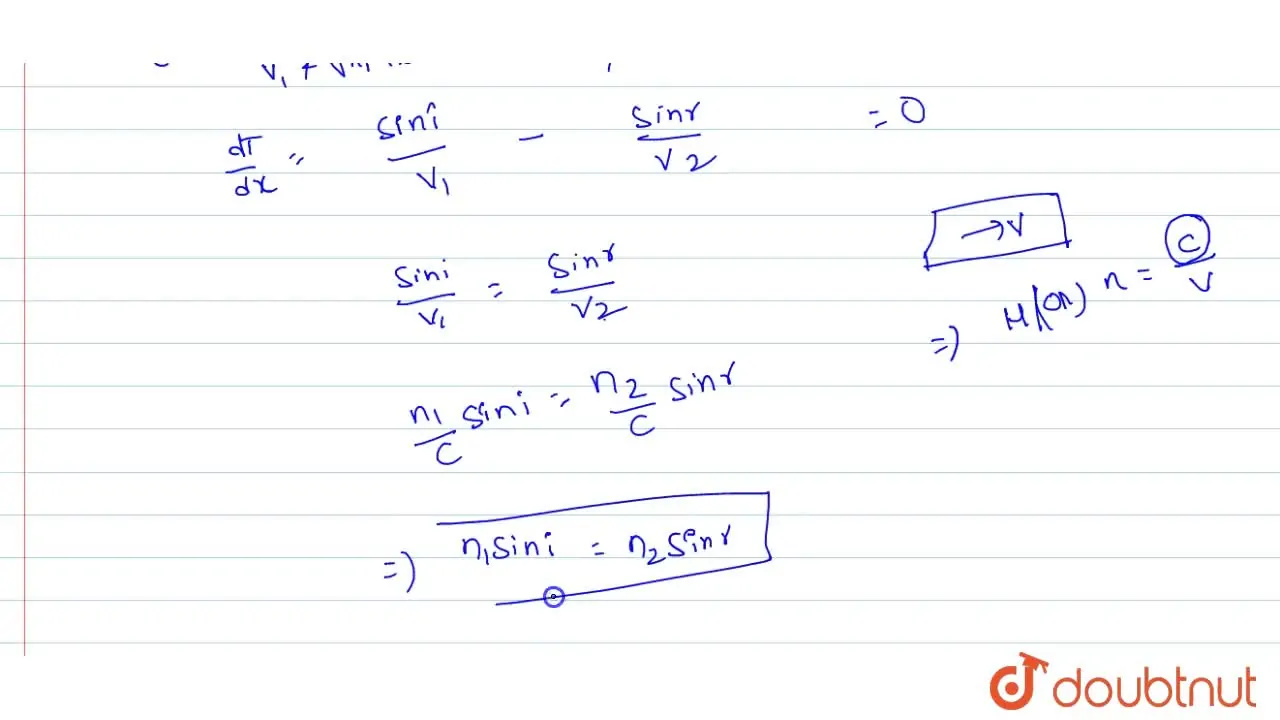Using Fermat's principle derive the laws of deflection and refraction of light on the plane interface between two media.
Fermat's principle : " The actual path of propagation o flight (trajectory of a light ray) is the path which can be followed by light with inb the lest time, in comparison with all other hypothetical paths between the same two points.''
''Above statement is the original wordings of Fermat (A famous French scienitst of 17th century)''
Deduction of the law of refraction from Femat's principle
Let the plane S be the interface between medium 1 and medium 2 with the refractive indices n1=c/v1 and n2=c/v2 Fig. Assumne, as usual, that n1<n2. two points are given-one above the plane S (point A), the other under plane S (point B). the various distance are :
∀1=h1,BB1=h2,A1B1=l. We must find the path from A to B which can be covered by light faster than it can cover any other hypothetical path. Clearly, this path consist S has to be found.
First of all, it follows from Fermat's principle that the point O must lie on the intersection of S and a plane P, which is perpendicualr to S and passed thorugh A and B.

Indeed, let us assume that his point does not lie in the plane P, let this be point O1 in Fig. Drop the perpendicular O1O2 from O1 onto P. Since AO2<AO1 and BO1, it is clear that the time required to traverse AO2 is less than that needed to cover tha path AO1B. Thus, using Fermat's principle, we see that the first law of refraction is observed : the incident and the refracted rays lie in the same plane as the perpendicualr to the interface at the point
where the ray is refracted. This plane is the plane P in Fig. it is called the plane of incidence.
Now let us consider light rays in the plane of incidence Fig. Designate A1O as x and OB1=l−x. The time it takes a ray to travel from A to O and then from O to B is
T=AOv1+OBv2=√h21+x2v1+√h22+(l−x)2v2 (1)
The time depends on the value of x. According to Fermat's principle, the value of x must minimize the time T. At this value of x the derivative dT/dx equals zero :
dTdx=xv1√h21+x2−l−xv2√h22+(l−x)2=0. (2)
Now,
x√h21+x2sinα, and l−x√h22+(l−x)2sinβ,
Consequently,
sinαv1−sinβv2=0, or sinαsinβ=v1v2
So, sinαsinβ=c/n1c/n2=n2n1
Note : Fermat himself could not use Eqn.2 as matghematical anaysis was developed later by Newton and leibniz. To deduce the law of the refraction of light, Fermat used his own maximum and minimum method of calculs, which in fact, correcponded to the subsequently developed method of finding the minimum (maximum) of a function by differentiating it and equating the derivative to zero.
Related Playlists
- BOOK - IE IRODOV, LA SENA & SS KROTOVCHAPTER - OPTICSEXERCISE - Interference Of Light33videos
OPTICS
- BOOK - IE IRODOV, LA SENA & SS KROTOVCHAPTER - OPTICSEXERCISE - Diffraction Of Light60videos
OPTICS
- BOOK - IE IRODOV, LA SENA & SS KROTOVCHAPTER - MECHANICSEXERCISE - Mechanics Problems92videos
MECHANICS
- BOOK - IE IRODOV, LA SENA & SS KROTOVCHAPTER - OSCILLATIONS AND WAVESEXERCISE - Electromagnetic Waves, Radiation36videos
OSCILLATIONS AND WAVES
Similar Questions
State laws of refraction of light.
View SolutionState and explain laws of refraction of light.
View SolutionState laws of refraction of light.
View SolutionReflection Of light and Refraction at plane surface
View SolutionDefine wavefront of a travelling wave. Using Huygens principle, obtain the law of refraction at a plane interface when light passes from rarer to a denser medium.
View SolutionDefine a wavefront. Using Huygen's principle, verifyi the laws of reflection at a plane surface.
View SolutionDefine a wavefront . Using Huygens principle ,verify the laws of reflection at a plane surface.
View SolutionDefine refraction of light. State Snell's law of refraction of light.
View SolutionProceeding from Fermat'sprinciple derive the refraction formula for paraxial rays on a spherical boundary surface of radius R between media with refractive indices n and n'.
View SolutionState Huygen's principle for the propagation of light and prove the laws of refraction of light on its basis.
View Solution


